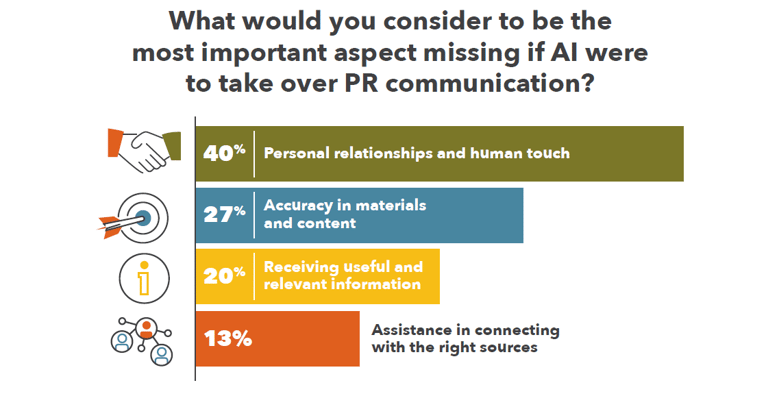Why the "relations" in media relations is here to stay
Since ChatGPT’s launch in late 2022, it’s been impossible to ignore the discussions around how AI will revolutionize the PR and marketing industry.
As PR professionals, it’s our job to explore the use of new technologies that have the potential to enhance our work. Before fully diving into AI, however, we must first take a step back to understand the consequences of AI in PR and the challenges that come with it.
To best understand how effective AI is in media relations, we consulted some of our journalist contacts to hear what they had to say. We heard from 15 journalists representing trade, local and national publications for B2C and B2B audiences, including U.S. News & World Report, Domino, cleveland.com and more, about their thoughts around the use of AI in the PR and journalism industries.
Here’s what we learned:
- Fourteen of the 15 journalists said the use of AI for pitches or other materials provided by PR representatives makes them question the credibility and/or accuracy of the information.
- All 15 journalists we surveyed do not think that AI can fully replace HI (human intelligence) when it comes to PR.
- Seventy-three percent of respondents said they would not consider using AI-generated imagery in their stories, with only 26% responding they would or were unsure.
- Seventy-three percent of respondents said they would be less likely to cover a story or press release if they knew it was generated or curated using AI.
- Twelve of the 15 journalists said that when receiving pitches or materials from a PR representative, they can always or sometimes tell if it has been written by AI.
Overwhelmingly, we heard that media contacts are hesitant to fully embrace AI-generated PR materials. According to Dawn Bradbury of U.S. News & World Report, “I have some credibility and accuracy concerns about the use of AI in pitches, press releases and PR materials, primarily because I think these things all involve judgment calls, creativity and solid subject matter expertise.”

Most of the respondents cited “personal relationships and human touch” as the most important aspects missing if AI were to take over PR communications. Accuracy, relevancy and connecting to the right sources were listed as the following three aspects.
So where does AI fit in PR?
My inbox has started to pile up with emails selling AI-powered press release writing, pitch development and even automated outreach to media contacts. Before hopping on the bandwagon of these AI service offerings, make sure you are using AI in ways that enhance your work and don’t replace or jeopardize it.
"I have some credibility and accuracy concerns about the use of AI in pitches, press releases and PR materials, primarily because I think these things all involve judgment calls, creativity and solid subject matter expertise."
– Dawn Bradbury, U.S. News & World Report
While AI has a place in our industry as a tool for inspiration and research, as PR professionals it’s important to acknowledge that technology is far from providing the service, creativity, credibility and intelligence a human can provide. According to Bradbury, “I feel comfortable with the role of AI in PR as it relates to data collection (media impressions, etc.), report generation, creating targeted media lists for interviews or press release distribution, managing social media and the like.”
If media are seeking the “human touch” in PR, agencies and companies must continue to communicate as humans. It’s imperative to have humans guiding your PR strategy and in the driver’s seat for one-on-one communications with journalists. Any content that hasn’t been reviewed by a human is not going to cut it.
We will continue to see agencies and companies find new ways to use AI in their PR programs, but one thing we know for sure is that the “relations” in media relations isn’t going anywhere anytime soon.
Written By Akhia
Explore These Topics
